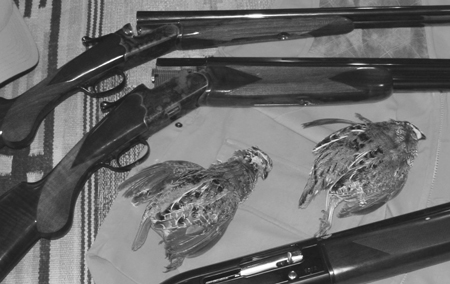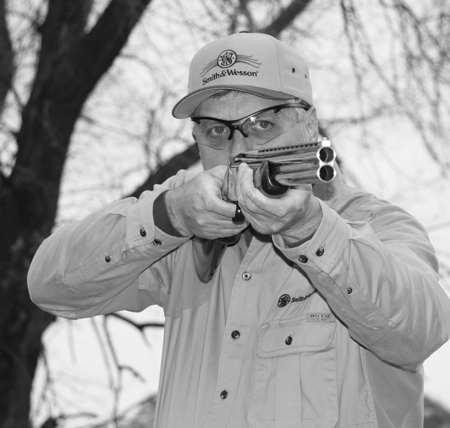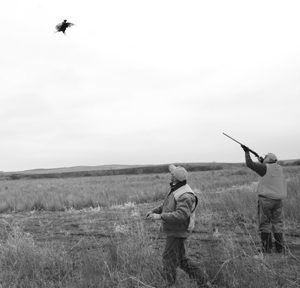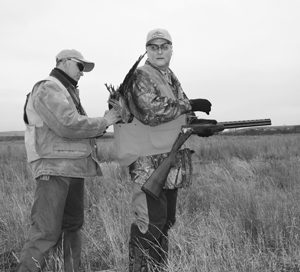
There's more than handguns at Smith & Wesson. In this gun review, the author takes a look at the Smith & Wesson Elite Gold Side-by-Side, Elite Silver Over-Under, and the since discontinued 1000 Series semi-auto.
Smith & Wesson: great semiauto handguns and revolvers! That’s the knee-jerk reaction made by most anyone who shoots but today, that assumption needs to expanded upon.
When it comes to rifles, they offer what I feel are some of the best semiautos for defense or varmint control, the M&P15 and the M&P15 PC chambered in .223 Remington/5.56 mm NATO. Of course, S&W Holding Corporation (Nasdaq: SWHC) has acquired Thompson/Center Arms, which adds T/C’s superb single shot rifles, handguns, slug guns, black powder arms, semiauto rimfire rifles and the new Icon bolt action rifle to S&W’s burgeoning product line.
But – shotguns? Yes, shotguns. For those of us old enough to have been interested in firearms in the 1970s, from 1972 until 1984 Smith & Wesson marketed pump and semi-auto shotguns that were manufactured by Howa in Japan. I fired one of these in a round of skeet years ago and that was all the experience I had with them.
Then at the 2007 SHOT Show in Orlando, Florida, at the writer shoot-out the day before the show, writers and guests all had the opportunity to fire the three new shotguns that now carry the Smith & Wesson name. Three years of work went into the market research for these shotguns; by not rushing the introduction, Smith & Wesson management did it right and covered all bases with a side-by-side, an over-under and a gas-operated semi-auto shotgun, all geared to the shooting sports and hunting.
Here is what these S&W shotguns are all about.
Elite Gold Side-By-Side
This type of shotgun, in years past, has been referred to as a “double-barrel,” which is a name that stuck long before over-and-under doubles became popular. As a kid, I remember the old Stevens Model 311 or Fox doubles which were working guns that were used and used hard, with little worry about dings and scratches. (One SXS – i.e., side-by-side – that I used for a round of skeet and did worry about scratching was a friend’s Winchester Model 21.)
Then came a market shift which saw affordable bread-and-butter doubles being eliminated and classics being retired. The double seemed to fade from the sporting community. Today, I have a new-found respect for fine guns which was strengthened through my hands-on-experience with the Smith & Wesson Elite Gold 2.75-inch and 3-inch side-by-side. I found this double to be both a work of art as well as quite functional in the field. It is also easy to carry, weighing in at around 6.5 lbs. in 20 gauge.
What also stands out is its hand-cut checkering (at 24 lines per inch) and engraving, which covers about 25% of the receiver. Its barrels are either 26 or 28 inches with the overall length being 43.5 or 45.5 inches, respectively. When the Elite Gold was introduced, the triggers were single, which I prefer. New in 2008 was the option for either of two styles of double triggers for the same price as the single-trigger version. For chokes, you have a IC/Mod bores. For those who appreciate a high-quality, well-figured piece of wood, the Elite Gold is available with an English or Prince of Wales stock of AAA grade Turkish Walnut. What is also obvious on the Elite Gold it is the precise metal to wood fit. This is only possible on firearms that are not run-of-the-mill, since fitting takes time and, as you know, time is money.

Elite Silver Over-Under
Back in my skeet shooting days when I shot competition, my Browning Superposed Diana had one frame/forend and four gauges of barrels, all balanced exactly. Due to this, they all swung and pointed the same and that became the action type I became accustomed to from thousands of rounds being fired in competition. This is probably why today I shoot an over-under the best.
Being a 12 gauge, the S & W Elite Silver weighs 7.6 to 7.8 pounds and is available with 2-3/4- or 3-inch chambers and 28 or 30 inch barrels. (Alas, the 26-inch length was discontinued in 2008.) There are five choke options: Cylinder, which is for skeet and sporting clays or grouse; Improved Cylinder; Modified; Improved Modified; and Full for those long shots.

This newly-designed Elite Silver shares many of the same custom design features as found on the Elite Gold series side-by-side and are also crafted with hand-engraved receivers finished in a bone-charcoal case hardening. Such a finish provides for a distinctive appearance as well as protection for the receiver.
An Elite Series Extra!
We have all heard of lifetime warranties that expire at the end of the original owner’s tenure. Smith & Wesson, again taking what many manufacturers had and expanding on it, did it again by coming up with their “Heirloom” warranty: with each purchase of an Elite Series shotgun, you get a lifetime warranty and then, when you pass either of these shotguns to whomever, your heir also has the same warranty protection you originally did. In my experience, a company who does this is one who obviously has the confidence that their product will continue on, trouble-free, into the next generation and then some.
When it comes to cost, the Elite Series models average $2,380 for either the side-by-side Gold or the over/under Silver, which is a lot less than I would have expected. With either purchase you get a fine, classic shotgun that is well-made, functional, practical and a work of art.
1000 Series Semiautos
[Editor’s Note: As this edition was going to press, Gun Digest learned that S&W’s 1000-Series semiauto shotguns have been discontinued. However, some will no doubt linger at retail for some time, so we present the following information for its historical value. -DMS.]

The Models 1012 Super (3-1/2-inch magnum), 1012 (2.75- or 3-inch 12 gauge) and 1020 (2.75- or 3-inch 20 gauge) gas-operated semi-automatics were designed for rough use and display excellent built-in handling characteristics.
Point, shoot, and the target goes down! Barrel lengths are 24, 26, and 28 inches as well as a 30-incher with TruGlo sights and ventilated rib. Five different choke tubes and a wrench are also included.
Weight of the 20 gauge, again depending on barrel length (24 or 26 inches) and stock material (wood versus synthetic) runs from 5.5 to 6.1 lbs. Overall lengths begin at 43.0 and go all the way to 50.5 inches for the 30-inch-barreled version that was discontinued in 2008. In 12 gauge, the weights vary from 6.3 to 7.5 lbs. with overall lengths from 45 to 51 inches – again, the latter for the 30-inch-barreled flavor.
Magazine capacity also varies, with the 12 gauge magnum holding 3 + 1 and the standard version 4 + 1. In the 20 gauge, it is 4 + 1 for all variations. The price of these shotguns in 2008 varied between $644 to around $735 in 20 gauge and is now slightly higher, primarily because of the falling dollar. The 12 gauge versions averaged between $644 for the 1012 to $882 for the 1012 Super – again, a bit more than that today because of the weak dollar.

Field Testing: An Oklahoma Quail Hunt
A hunt to field-test these new shotguns was held for a few writers and personnel from Smith & Wesson/Blue Heron Communications at the famed Selman Ranch in Oklahoma. This is a 14,000-acre ranch located in the northwest part of that state, and it’s quite famous. In fact, there was even a book written about this ranch’s history. This book, The Buffalo Creek Chronicles, by Lantzy and House, tells how the Selman family carved out a living on this land, one rich in game throughout its sagebrush-covered rolling hills.
As we arrived and drove into the ranch area, in certain ways it was like going back in time. As a kid, I remember my grandmother’s farm and the machinery of the day, now all gone. It was good to see a lot of the equipment of our past still onsite, reminding us of the jobs it had once accomplished. Then it was time to check in, head to the main house to eat dinner, and then hit the sack in preparation for two days of shooting.
The following morning, we woke up to a great breakfast to begin the day. Then we were directed to a shooting area about a half mile away where Colie Selman, the staff and our group set up clay target throwers to give us all practical experience with the new shotguns.
I did shoot all of these at the SHOT Show but now we could shoot all we desired and fire at targets not confined to “straightaways” but angled or, to add difficulty, launched right off the ground as a quail flies. After a few hours of shooting, we broke up into two groups and with dogs and a skilled handler in tow, it was off to try our luck. After a few hours of hunting, we met for lunch and in the afternoon, we went out to other areas to hunt some more.
 When flushed, grouse move and move fast, and here is when a shotgun that fits and naturally swings as the Elite Silver does is necessary to consistently point, shoot and drop that bird. I really appreciated the S&W over-under, an action type I have always done my best with.
When flushed, grouse move and move fast, and here is when a shotgun that fits and naturally swings as the Elite Silver does is necessary to consistently point, shoot and drop that bird. I really appreciated the S&W over-under, an action type I have always done my best with.
The next day, we had the option to go back to quail areas or try fields with pheasants. I opted for the pheasants. Again, the dogs were great and their pointing gave the hunters a few seconds to switch mental gears so to be ready for that flush that would happen any second. When it did happen, the birds’ flight patterns were not as fast as the quails’ but seemed to be more erratic. Again, this is where a shotgun that naturally points greatly helped me harvest that bird.
What made a lasting impression on me with these three shotguns, especially the semi-autos, was that even when filthy, they simply did not malfunction. During all that shooting – and gun writers have never been known for being over-protective with test guns – the S&W shotguns continued to work flawlessly. Even though I at times have a mental block with any side-by-side shotgun, the Elite Gold 20 gauge was a pleasure to carry and shoot.
With over-under and semi-autos admittedly being my preference, I was not disappointed with the Elite Silver over/under or the Series 1000 semiautos. The 12-gauge models I shot were on the heavy side but, being so well balanced, they made swinging and point shooting feel natural. When you’re hunting and a bird goes up, the shotgun should be shouldered and fired almost instinctively. If your alignment is good, the bird falls out of the sky. When this consistently happens, at least part of the credit should go to the shotgun – and credit is certainly due to the new S&W shotguns.
What was also interesting was that none of the S&W shotguns was a favorite of everyone. Some preferred the 20 gauge side-by-side, others the over-under and others the semi-auto, which just goes to show you that love is ever in the eye of the beholder. It also means that there is something for everyone from Smith & Wesson.
Entering the shotgun market was an adventurous step for a company whose expertise was, and still is, handguns. Yet it was that adventurous attitude that drove S&W to apply for new patents and to build a plant in Turkey dedicated entirely to ensuring the quality of these new shotguns.
Sources for Additional Information:
Boyt Harness Company
www.boytharness.com (800) 550-2698
Smith & Wesson
www.smith-wesson.com (800) 331-0852
Selman Ranch
www.selmanranch.com (580) 256-2006
This article is an excerpt from Gun Digest 2011.

Next Step: Get your FREE Printable Target Pack
Enhance your shooting precision with our 62 MOA Targets, perfect for rifles and handguns. Crafted in collaboration with Storm Tactical for accuracy and versatility.
Subscribe to the Gun Digest email newsletter and get your downloadable target pack sent straight to your inbox. Stay updated with the latest firearms info in the industry.


![Best Concealed Carry Guns In 2025 [Field Tested] Wilson Combat EDC X9S 1](https://gundigest.com/wp-content/uploads/Wilson-Combat-EDC-X9S-1-324x160.jpg)


![Best 9mm Carbine: Affordable PCCs [Tested] Ruger Carbine Shooting](https://gundigest.com/wp-content/uploads/Ruger-Carbine-Shooting-100x70.jpg)
![Best AR-15: Top Options Available Today [Field Tested] Harrington and Richardson PSA XM177E2 feature](https://gundigest.com/wp-content/uploads/Harrington-and-Richardson-PSA-XM177E2-feature-100x70.jpg)
